Project Management Report: Project Management Overview and Analysis
VerifiedAdded on 2020/06/06
|20
|4932
|112
Report
AI Summary
This report provides a detailed overview of project management, encompassing key aspects such as project characteristics, scope statements, and Gantt charts. It delves into budget development considerations, risk management strategies, and quality methods essential for successful project completion. The report also explores the skills and competencies of a project manager, the project lifecycle stages (conceptualization, development, implementation), and the importance of leadership. Furthermore, it includes risk analysis and provides a comprehensive understanding of project management principles and practices. The report examines a case study involving the installation of information technology and communication infrastructure in the City Towers Hotel, London, outlining goals, objectives, and stakeholder considerations. The report also covers the skills and competencies of project managers, the project process, and the project life cycle. It includes the conceptualization, development, implementation, and termination stages. Finally, the report offers insights into the essential elements of project management, from initiation to project closure, and provides a framework for effective project execution.

Paraphrase This Document
Need a fresh take? Get an instant paraphrase of this document with our AI Paraphraser
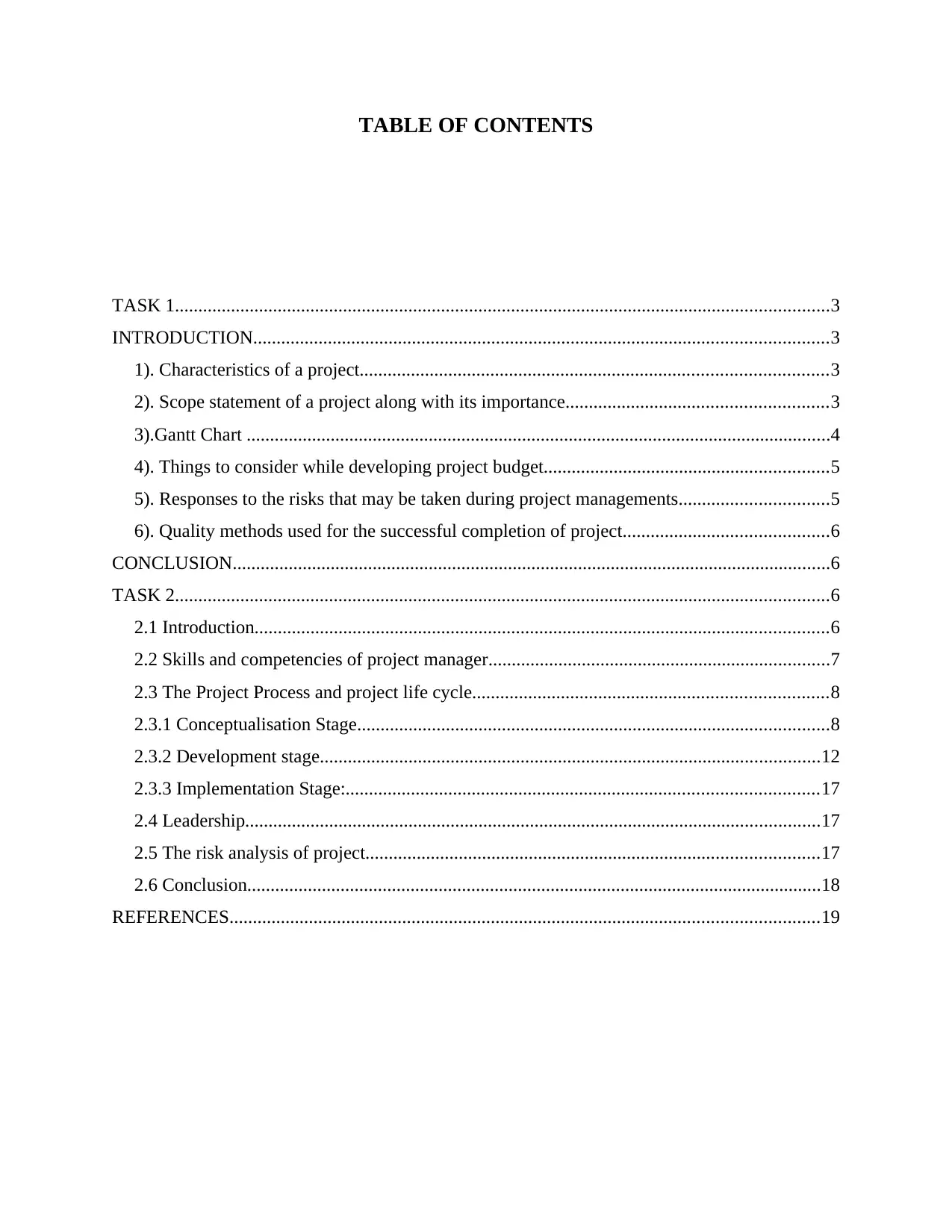
TABLE OF CONTENTS
TASK 1............................................................................................................................................3
INTRODUCTION...........................................................................................................................3
1). Characteristics of a project....................................................................................................3
2). Scope statement of a project along with its importance........................................................3
3).Gantt Chart .............................................................................................................................4
4). Things to consider while developing project budget.............................................................5
5). Responses to the risks that may be taken during project managements................................5
6). Quality methods used for the successful completion of project............................................6
CONCLUSION................................................................................................................................6
TASK 2............................................................................................................................................6
2.1 Introduction...........................................................................................................................6
2.2 Skills and competencies of project manager.........................................................................7
2.3 The Project Process and project life cycle............................................................................8
2.3.1 Conceptualisation Stage.....................................................................................................8
2.3.2 Development stage...........................................................................................................12
2.3.3 Implementation Stage:.....................................................................................................17
2.4 Leadership...........................................................................................................................17
2.5 The risk analysis of project.................................................................................................17
2.6 Conclusion...........................................................................................................................18
REFERENCES..............................................................................................................................19
TASK 1............................................................................................................................................3
INTRODUCTION...........................................................................................................................3
1). Characteristics of a project....................................................................................................3
2). Scope statement of a project along with its importance........................................................3
3).Gantt Chart .............................................................................................................................4
4). Things to consider while developing project budget.............................................................5
5). Responses to the risks that may be taken during project managements................................5
6). Quality methods used for the successful completion of project............................................6
CONCLUSION................................................................................................................................6
TASK 2............................................................................................................................................6
2.1 Introduction...........................................................................................................................6
2.2 Skills and competencies of project manager.........................................................................7
2.3 The Project Process and project life cycle............................................................................8
2.3.1 Conceptualisation Stage.....................................................................................................8
2.3.2 Development stage...........................................................................................................12
2.3.3 Implementation Stage:.....................................................................................................17
2.4 Leadership...........................................................................................................................17
2.5 The risk analysis of project.................................................................................................17
2.6 Conclusion...........................................................................................................................18
REFERENCES..............................................................................................................................19
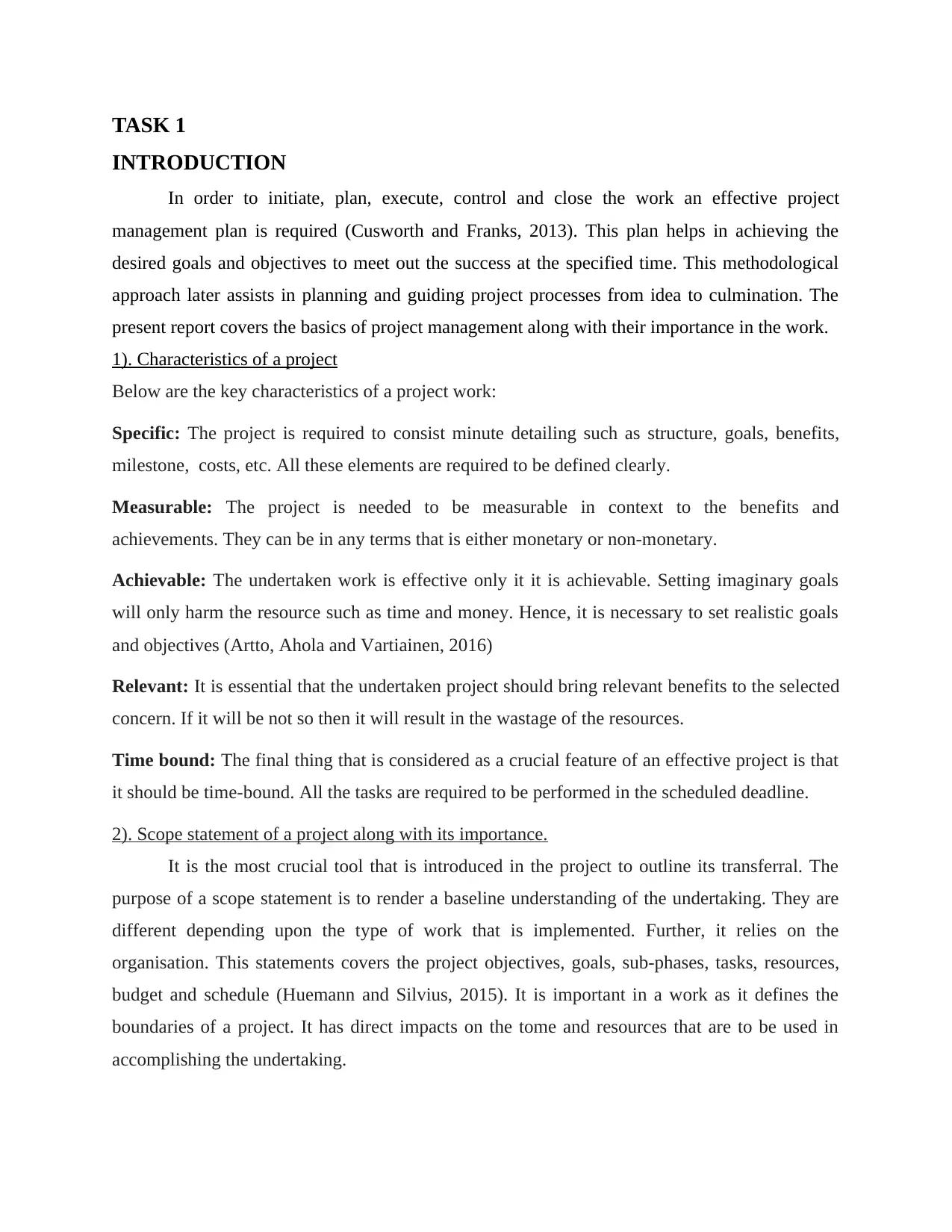
TASK 1
INTRODUCTION
In order to initiate, plan, execute, control and close the work an effective project
management plan is required (Cusworth and Franks, 2013). This plan helps in achieving the
desired goals and objectives to meet out the success at the specified time. This methodological
approach later assists in planning and guiding project processes from idea to culmination. The
present report covers the basics of project management along with their importance in the work.
1). Characteristics of a project
Below are the key characteristics of a project work:
Specific: The project is required to consist minute detailing such as structure, goals, benefits,
milestone, costs, etc. All these elements are required to be defined clearly.
Measurable: The project is needed to be measurable in context to the benefits and
achievements. They can be in any terms that is either monetary or non-monetary.
Achievable: The undertaken work is effective only it it is achievable. Setting imaginary goals
will only harm the resource such as time and money. Hence, it is necessary to set realistic goals
and objectives (Artto, Ahola and Vartiainen, 2016)
Relevant: It is essential that the undertaken project should bring relevant benefits to the selected
concern. If it will be not so then it will result in the wastage of the resources.
Time bound: The final thing that is considered as a crucial feature of an effective project is that
it should be time-bound. All the tasks are required to be performed in the scheduled deadline.
2). Scope statement of a project along with its importance.
It is the most crucial tool that is introduced in the project to outline its transferral. The
purpose of a scope statement is to render a baseline understanding of the undertaking. They are
different depending upon the type of work that is implemented. Further, it relies on the
organisation. This statements covers the project objectives, goals, sub-phases, tasks, resources,
budget and schedule (Huemann and Silvius, 2015). It is important in a work as it defines the
boundaries of a project. It has direct impacts on the tome and resources that are to be used in
accomplishing the undertaking.
INTRODUCTION
In order to initiate, plan, execute, control and close the work an effective project
management plan is required (Cusworth and Franks, 2013). This plan helps in achieving the
desired goals and objectives to meet out the success at the specified time. This methodological
approach later assists in planning and guiding project processes from idea to culmination. The
present report covers the basics of project management along with their importance in the work.
1). Characteristics of a project
Below are the key characteristics of a project work:
Specific: The project is required to consist minute detailing such as structure, goals, benefits,
milestone, costs, etc. All these elements are required to be defined clearly.
Measurable: The project is needed to be measurable in context to the benefits and
achievements. They can be in any terms that is either monetary or non-monetary.
Achievable: The undertaken work is effective only it it is achievable. Setting imaginary goals
will only harm the resource such as time and money. Hence, it is necessary to set realistic goals
and objectives (Artto, Ahola and Vartiainen, 2016)
Relevant: It is essential that the undertaken project should bring relevant benefits to the selected
concern. If it will be not so then it will result in the wastage of the resources.
Time bound: The final thing that is considered as a crucial feature of an effective project is that
it should be time-bound. All the tasks are required to be performed in the scheduled deadline.
2). Scope statement of a project along with its importance.
It is the most crucial tool that is introduced in the project to outline its transferral. The
purpose of a scope statement is to render a baseline understanding of the undertaking. They are
different depending upon the type of work that is implemented. Further, it relies on the
organisation. This statements covers the project objectives, goals, sub-phases, tasks, resources,
budget and schedule (Huemann and Silvius, 2015). It is important in a work as it defines the
boundaries of a project. It has direct impacts on the tome and resources that are to be used in
accomplishing the undertaking.
⊘ This is a preview!⊘
Do you want full access?
Subscribe today to unlock all pages.

Trusted by 1+ million students worldwide

3).Gantt Chart
Calculation of critical path:
1+3+6
Project Duration:
2+1+8= 11 days
In accordance with the above chart given, it can be stated that to complete the project, it
will take up to 11 days when all the critical path is considered. In order to 10 days can be saved
in the undertaking and it can be completed as per the plan developed (Martinelli, Waddell and
Rahschulte, 2017)
Calculation of critical path:
1+3+6
Project Duration:
2+1+8= 11 days
In accordance with the above chart given, it can be stated that to complete the project, it
will take up to 11 days when all the critical path is considered. In order to 10 days can be saved
in the undertaking and it can be completed as per the plan developed (Martinelli, Waddell and
Rahschulte, 2017)
Paraphrase This Document
Need a fresh take? Get an instant paraphrase of this document with our AI Paraphraser
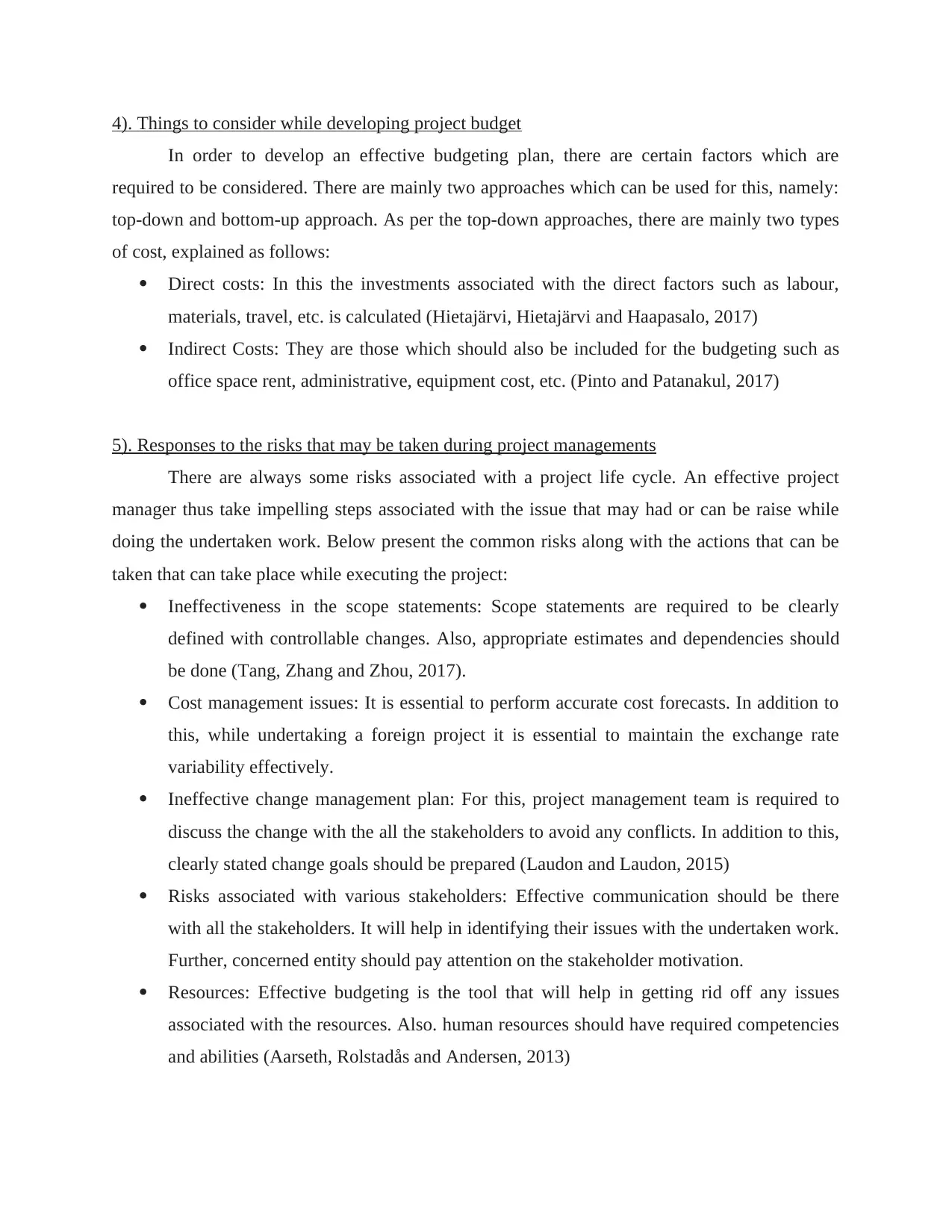
4). Things to consider while developing project budget
In order to develop an effective budgeting plan, there are certain factors which are
required to be considered. There are mainly two approaches which can be used for this, namely:
top-down and bottom-up approach. As per the top-down approaches, there are mainly two types
of cost, explained as follows:
Direct costs: In this the investments associated with the direct factors such as labour,
materials, travel, etc. is calculated (Hietajärvi, Hietajärvi and Haapasalo, 2017)
Indirect Costs: They are those which should also be included for the budgeting such as
office space rent, administrative, equipment cost, etc. (Pinto and Patanakul, 2017)
5). Responses to the risks that may be taken during project managements
There are always some risks associated with a project life cycle. An effective project
manager thus take impelling steps associated with the issue that may had or can be raise while
doing the undertaken work. Below present the common risks along with the actions that can be
taken that can take place while executing the project:
Ineffectiveness in the scope statements: Scope statements are required to be clearly
defined with controllable changes. Also, appropriate estimates and dependencies should
be done (Tang, Zhang and Zhou, 2017).
Cost management issues: It is essential to perform accurate cost forecasts. In addition to
this, while undertaking a foreign project it is essential to maintain the exchange rate
variability effectively.
Ineffective change management plan: For this, project management team is required to
discuss the change with the all the stakeholders to avoid any conflicts. In addition to this,
clearly stated change goals should be prepared (Laudon and Laudon, 2015)
Risks associated with various stakeholders: Effective communication should be there
with all the stakeholders. It will help in identifying their issues with the undertaken work.
Further, concerned entity should pay attention on the stakeholder motivation.
Resources: Effective budgeting is the tool that will help in getting rid off any issues
associated with the resources. Also. human resources should have required competencies
and abilities (Aarseth, Rolstadås and Andersen, 2013)
In order to develop an effective budgeting plan, there are certain factors which are
required to be considered. There are mainly two approaches which can be used for this, namely:
top-down and bottom-up approach. As per the top-down approaches, there are mainly two types
of cost, explained as follows:
Direct costs: In this the investments associated with the direct factors such as labour,
materials, travel, etc. is calculated (Hietajärvi, Hietajärvi and Haapasalo, 2017)
Indirect Costs: They are those which should also be included for the budgeting such as
office space rent, administrative, equipment cost, etc. (Pinto and Patanakul, 2017)
5). Responses to the risks that may be taken during project managements
There are always some risks associated with a project life cycle. An effective project
manager thus take impelling steps associated with the issue that may had or can be raise while
doing the undertaken work. Below present the common risks along with the actions that can be
taken that can take place while executing the project:
Ineffectiveness in the scope statements: Scope statements are required to be clearly
defined with controllable changes. Also, appropriate estimates and dependencies should
be done (Tang, Zhang and Zhou, 2017).
Cost management issues: It is essential to perform accurate cost forecasts. In addition to
this, while undertaking a foreign project it is essential to maintain the exchange rate
variability effectively.
Ineffective change management plan: For this, project management team is required to
discuss the change with the all the stakeholders to avoid any conflicts. In addition to this,
clearly stated change goals should be prepared (Laudon and Laudon, 2015)
Risks associated with various stakeholders: Effective communication should be there
with all the stakeholders. It will help in identifying their issues with the undertaken work.
Further, concerned entity should pay attention on the stakeholder motivation.
Resources: Effective budgeting is the tool that will help in getting rid off any issues
associated with the resources. Also. human resources should have required competencies
and abilities (Aarseth, Rolstadås and Andersen, 2013)
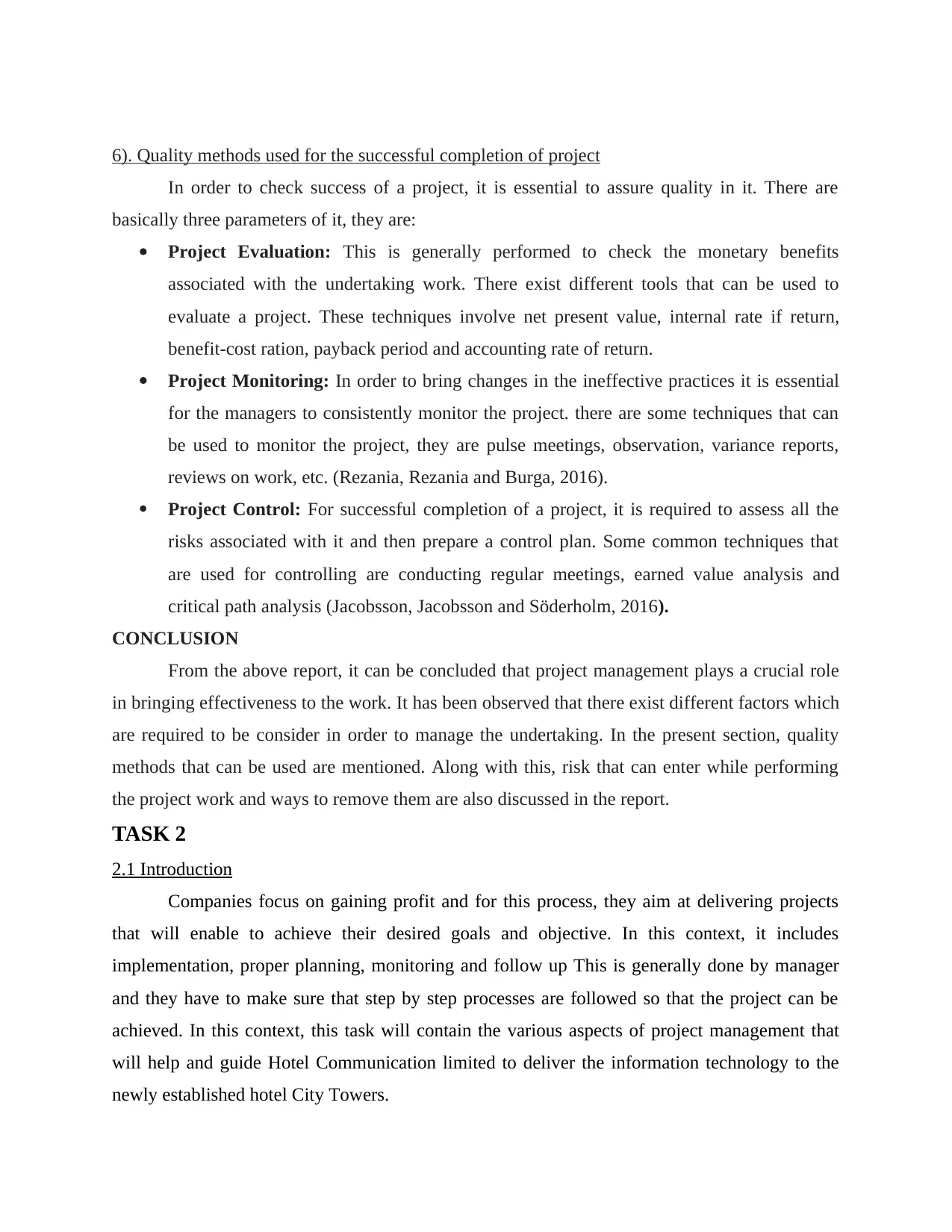
6). Quality methods used for the successful completion of project
In order to check success of a project, it is essential to assure quality in it. There are
basically three parameters of it, they are:
Project Evaluation: This is generally performed to check the monetary benefits
associated with the undertaking work. There exist different tools that can be used to
evaluate a project. These techniques involve net present value, internal rate if return,
benefit-cost ration, payback period and accounting rate of return.
Project Monitoring: In order to bring changes in the ineffective practices it is essential
for the managers to consistently monitor the project. there are some techniques that can
be used to monitor the project, they are pulse meetings, observation, variance reports,
reviews on work, etc. (Rezania, Rezania and Burga, 2016).
Project Control: For successful completion of a project, it is required to assess all the
risks associated with it and then prepare a control plan. Some common techniques that
are used for controlling are conducting regular meetings, earned value analysis and
critical path analysis (Jacobsson, Jacobsson and Söderholm, 2016).
CONCLUSION
From the above report, it can be concluded that project management plays a crucial role
in bringing effectiveness to the work. It has been observed that there exist different factors which
are required to be consider in order to manage the undertaking. In the present section, quality
methods that can be used are mentioned. Along with this, risk that can enter while performing
the project work and ways to remove them are also discussed in the report.
TASK 2
2.1 Introduction
Companies focus on gaining profit and for this process, they aim at delivering projects
that will enable to achieve their desired goals and objective. In this context, it includes
implementation, proper planning, monitoring and follow up This is generally done by manager
and they have to make sure that step by step processes are followed so that the project can be
achieved. In this context, this task will contain the various aspects of project management that
will help and guide Hotel Communication limited to deliver the information technology to the
newly established hotel City Towers.
In order to check success of a project, it is essential to assure quality in it. There are
basically three parameters of it, they are:
Project Evaluation: This is generally performed to check the monetary benefits
associated with the undertaking work. There exist different tools that can be used to
evaluate a project. These techniques involve net present value, internal rate if return,
benefit-cost ration, payback period and accounting rate of return.
Project Monitoring: In order to bring changes in the ineffective practices it is essential
for the managers to consistently monitor the project. there are some techniques that can
be used to monitor the project, they are pulse meetings, observation, variance reports,
reviews on work, etc. (Rezania, Rezania and Burga, 2016).
Project Control: For successful completion of a project, it is required to assess all the
risks associated with it and then prepare a control plan. Some common techniques that
are used for controlling are conducting regular meetings, earned value analysis and
critical path analysis (Jacobsson, Jacobsson and Söderholm, 2016).
CONCLUSION
From the above report, it can be concluded that project management plays a crucial role
in bringing effectiveness to the work. It has been observed that there exist different factors which
are required to be consider in order to manage the undertaking. In the present section, quality
methods that can be used are mentioned. Along with this, risk that can enter while performing
the project work and ways to remove them are also discussed in the report.
TASK 2
2.1 Introduction
Companies focus on gaining profit and for this process, they aim at delivering projects
that will enable to achieve their desired goals and objective. In this context, it includes
implementation, proper planning, monitoring and follow up This is generally done by manager
and they have to make sure that step by step processes are followed so that the project can be
achieved. In this context, this task will contain the various aspects of project management that
will help and guide Hotel Communication limited to deliver the information technology to the
newly established hotel City Towers.
⊘ This is a preview!⊘
Do you want full access?
Subscribe today to unlock all pages.

Trusted by 1+ million students worldwide
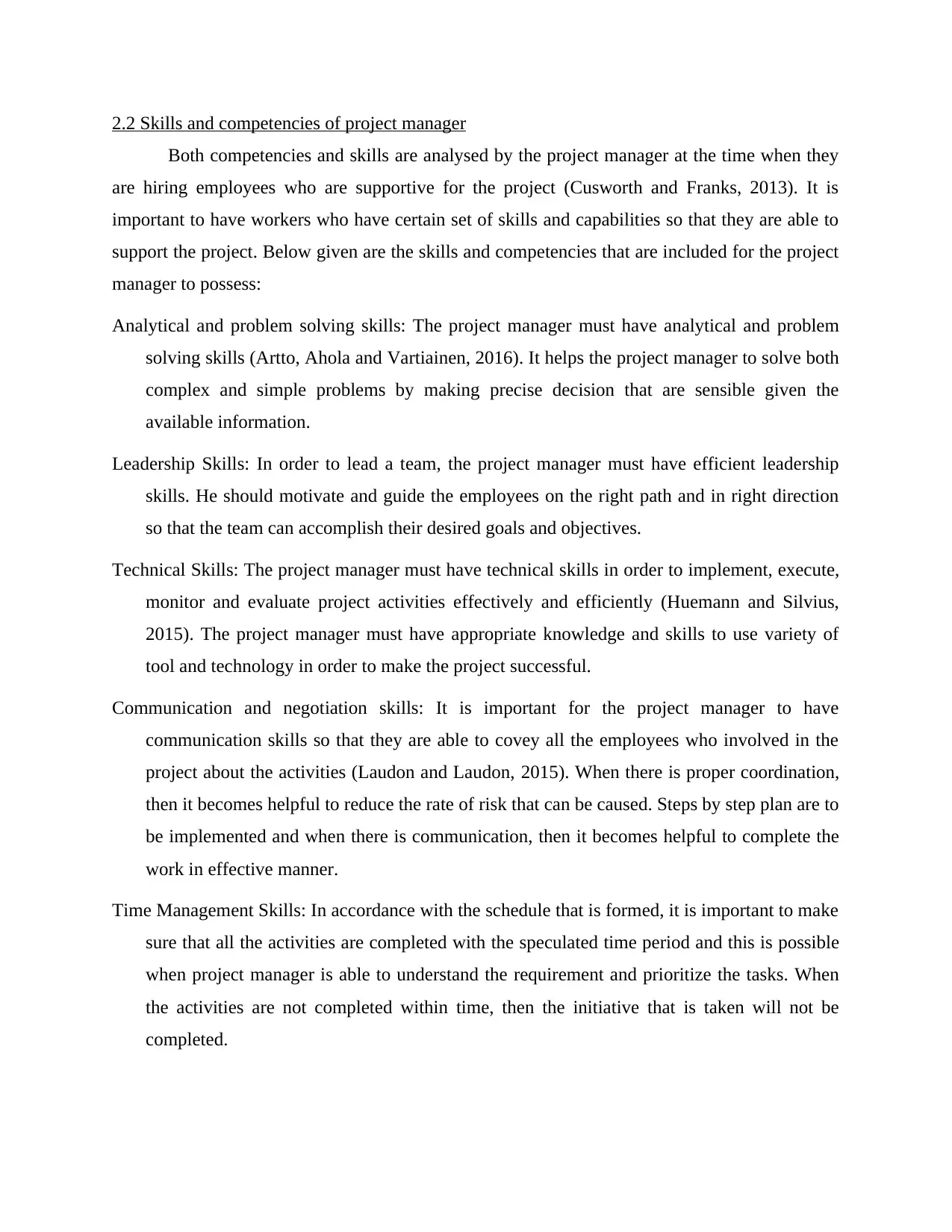
2.2 Skills and competencies of project manager
Both competencies and skills are analysed by the project manager at the time when they
are hiring employees who are supportive for the project (Cusworth and Franks, 2013). It is
important to have workers who have certain set of skills and capabilities so that they are able to
support the project. Below given are the skills and competencies that are included for the project
manager to possess:
Analytical and problem solving skills: The project manager must have analytical and problem
solving skills (Artto, Ahola and Vartiainen, 2016). It helps the project manager to solve both
complex and simple problems by making precise decision that are sensible given the
available information.
Leadership Skills: In order to lead a team, the project manager must have efficient leadership
skills. He should motivate and guide the employees on the right path and in right direction
so that the team can accomplish their desired goals and objectives.
Technical Skills: The project manager must have technical skills in order to implement, execute,
monitor and evaluate project activities effectively and efficiently (Huemann and Silvius,
2015). The project manager must have appropriate knowledge and skills to use variety of
tool and technology in order to make the project successful.
Communication and negotiation skills: It is important for the project manager to have
communication skills so that they are able to covey all the employees who involved in the
project about the activities (Laudon and Laudon, 2015). When there is proper coordination,
then it becomes helpful to reduce the rate of risk that can be caused. Steps by step plan are to
be implemented and when there is communication, then it becomes helpful to complete the
work in effective manner.
Time Management Skills: In accordance with the schedule that is formed, it is important to make
sure that all the activities are completed with the speculated time period and this is possible
when project manager is able to understand the requirement and prioritize the tasks. When
the activities are not completed within time, then the initiative that is taken will not be
completed.
Both competencies and skills are analysed by the project manager at the time when they
are hiring employees who are supportive for the project (Cusworth and Franks, 2013). It is
important to have workers who have certain set of skills and capabilities so that they are able to
support the project. Below given are the skills and competencies that are included for the project
manager to possess:
Analytical and problem solving skills: The project manager must have analytical and problem
solving skills (Artto, Ahola and Vartiainen, 2016). It helps the project manager to solve both
complex and simple problems by making precise decision that are sensible given the
available information.
Leadership Skills: In order to lead a team, the project manager must have efficient leadership
skills. He should motivate and guide the employees on the right path and in right direction
so that the team can accomplish their desired goals and objectives.
Technical Skills: The project manager must have technical skills in order to implement, execute,
monitor and evaluate project activities effectively and efficiently (Huemann and Silvius,
2015). The project manager must have appropriate knowledge and skills to use variety of
tool and technology in order to make the project successful.
Communication and negotiation skills: It is important for the project manager to have
communication skills so that they are able to covey all the employees who involved in the
project about the activities (Laudon and Laudon, 2015). When there is proper coordination,
then it becomes helpful to reduce the rate of risk that can be caused. Steps by step plan are to
be implemented and when there is communication, then it becomes helpful to complete the
work in effective manner.
Time Management Skills: In accordance with the schedule that is formed, it is important to make
sure that all the activities are completed with the speculated time period and this is possible
when project manager is able to understand the requirement and prioritize the tasks. When
the activities are not completed within time, then the initiative that is taken will not be
completed.
Paraphrase This Document
Need a fresh take? Get an instant paraphrase of this document with our AI Paraphraser

Change Management skills: There are situations which changes are made in between the project.
It is important that the manager is flexible and accept the changes and adjust with it. In case,
manager is not able to understand the requirements, then it is essential that appropriate steps
are taken with the help of which the change can be implemented.
Planning skills: For the implementation of the project, it is important that proper steps are taken
in which all the activities are scheduled properly so that they are completed and project
goals are attained (Rezania, Rezania and Burga, 2016). When the project manager is not able
to form proper activities, then it becomes difficult for them to divide the work as per the
capabilities that each of the employee possess. This way it can be stated that project
manager is able to put on their efforts to complete the project in effective manner.
2.3 The Project Process and project life cycle
In this process the project management plan will be prepared for Hotel Communication
limited which will help them to supply the information and technology facilities to the City
Towers. The project management process follows the project life cycle stage which is comprises
of four stages which are provided below:
Conceptualisation Stage
Development Stage
Implementation Stage
Termination stage
The description of activities are as follows:
2.3.1 Conceptualisation Stage
This is the first stage of the project life cycle in which the project manager collects the
relevant information and data. The data related with the stakeholders need, outcome of project,
requirements of resources, project activities, etc.
Project Title
The title of the project is “Installation of information technology and communication
infrastructure in the City Towers Hotel, London”.
Goals and objectives
It is important that the manager is flexible and accept the changes and adjust with it. In case,
manager is not able to understand the requirements, then it is essential that appropriate steps
are taken with the help of which the change can be implemented.
Planning skills: For the implementation of the project, it is important that proper steps are taken
in which all the activities are scheduled properly so that they are completed and project
goals are attained (Rezania, Rezania and Burga, 2016). When the project manager is not able
to form proper activities, then it becomes difficult for them to divide the work as per the
capabilities that each of the employee possess. This way it can be stated that project
manager is able to put on their efforts to complete the project in effective manner.
2.3 The Project Process and project life cycle
In this process the project management plan will be prepared for Hotel Communication
limited which will help them to supply the information and technology facilities to the City
Towers. The project management process follows the project life cycle stage which is comprises
of four stages which are provided below:
Conceptualisation Stage
Development Stage
Implementation Stage
Termination stage
The description of activities are as follows:
2.3.1 Conceptualisation Stage
This is the first stage of the project life cycle in which the project manager collects the
relevant information and data. The data related with the stakeholders need, outcome of project,
requirements of resources, project activities, etc.
Project Title
The title of the project is “Installation of information technology and communication
infrastructure in the City Towers Hotel, London”.
Goals and objectives

The goals and objectives of the project will aid the project manager to conduct the project
efficiently. In this context, the goals and objectives of the project are as follows:
Delivering and installation of information technology and communication infrastructure
in the City Towers Hotel
Establishing information technology for booking and marketing
To improve the entertainment facilities by installation of TV and Radio provisions in the
rooms of City Towers Hotel.
To improve the security facility by installing the CCTV cameras in the premises. Installing precise information technology facilities in the meeting and conference rooms
of the hotel.
Key Stakeholders
Stakeholders plays vital role in project management. In this context the key stakeholders are
shown below in the table:
Key stakeholders Stakeholder Parties Information needs to be
consider
Customer or project client City Tower Hotel Ensuring to deliver the high
quality and durable products
that will enhance the quality of
project.
Sponsor of Project City Tower Hotel Ensure to provide an effective
system within the Hotel that
will aid in growth and
development of the
organisation.
Champion of Project Hotel Communication limited The organisation aims to
provide high quality products
at affordable price. This will
efficiently. In this context, the goals and objectives of the project are as follows:
Delivering and installation of information technology and communication infrastructure
in the City Towers Hotel
Establishing information technology for booking and marketing
To improve the entertainment facilities by installation of TV and Radio provisions in the
rooms of City Towers Hotel.
To improve the security facility by installing the CCTV cameras in the premises. Installing precise information technology facilities in the meeting and conference rooms
of the hotel.
Key Stakeholders
Stakeholders plays vital role in project management. In this context the key stakeholders are
shown below in the table:
Key stakeholders Stakeholder Parties Information needs to be
consider
Customer or project client City Tower Hotel Ensuring to deliver the high
quality and durable products
that will enhance the quality of
project.
Sponsor of Project City Tower Hotel Ensure to provide an effective
system within the Hotel that
will aid in growth and
development of the
organisation.
Champion of Project Hotel Communication limited The organisation aims to
provide high quality products
at affordable price. This will
⊘ This is a preview!⊘
Do you want full access?
Subscribe today to unlock all pages.

Trusted by 1+ million students worldwide
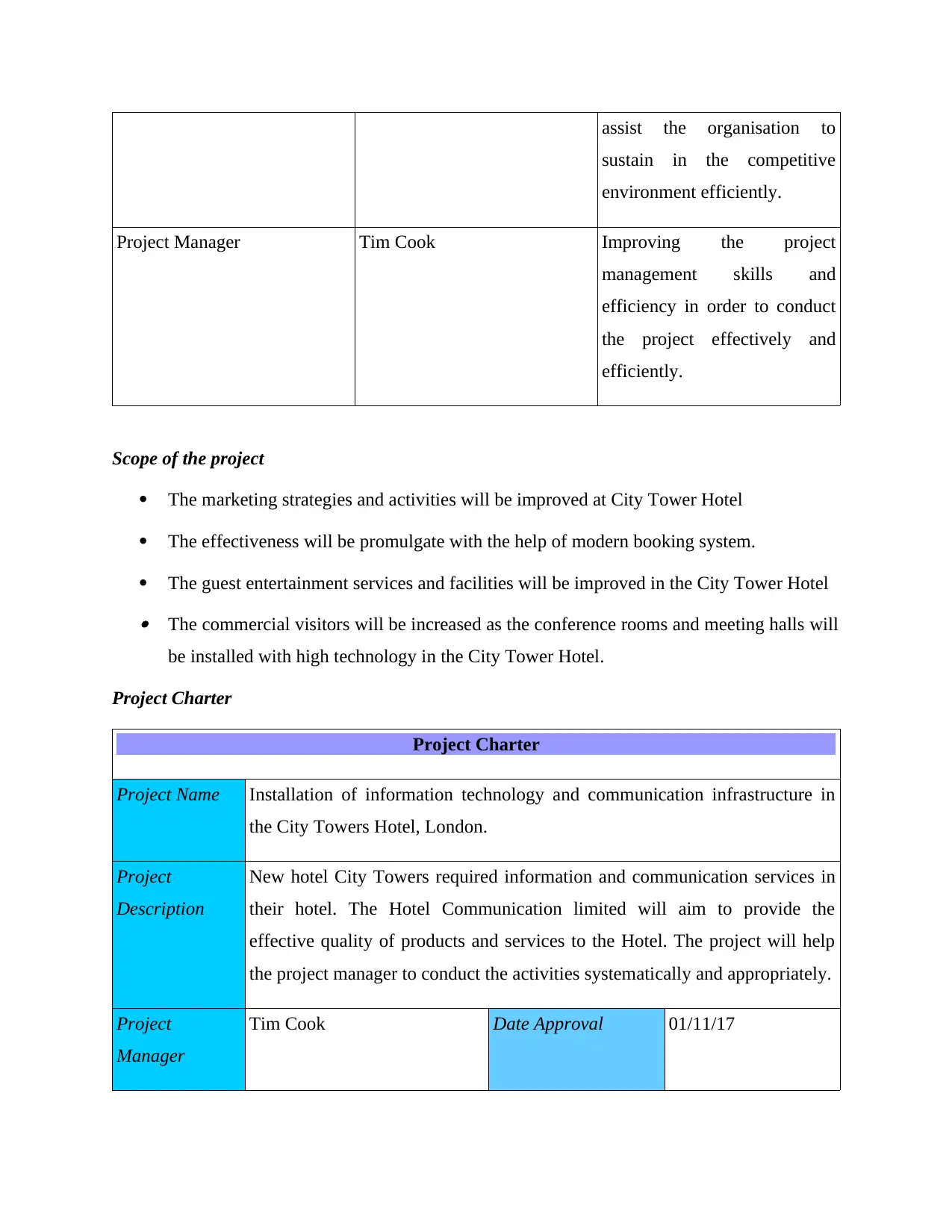
assist the organisation to
sustain in the competitive
environment efficiently.
Project Manager Tim Cook Improving the project
management skills and
efficiency in order to conduct
the project effectively and
efficiently.
Scope of the project
The marketing strategies and activities will be improved at City Tower Hotel
The effectiveness will be promulgate with the help of modern booking system.
The guest entertainment services and facilities will be improved in the City Tower Hotel The commercial visitors will be increased as the conference rooms and meeting halls will
be installed with high technology in the City Tower Hotel.
Project Charter
Project Charter
Project Name Installation of information technology and communication infrastructure in
the City Towers Hotel, London.
Project
Description
New hotel City Towers required information and communication services in
their hotel. The Hotel Communication limited will aim to provide the
effective quality of products and services to the Hotel. The project will help
the project manager to conduct the activities systematically and appropriately.
Project
Manager
Tim Cook Date Approval 01/11/17
sustain in the competitive
environment efficiently.
Project Manager Tim Cook Improving the project
management skills and
efficiency in order to conduct
the project effectively and
efficiently.
Scope of the project
The marketing strategies and activities will be improved at City Tower Hotel
The effectiveness will be promulgate with the help of modern booking system.
The guest entertainment services and facilities will be improved in the City Tower Hotel The commercial visitors will be increased as the conference rooms and meeting halls will
be installed with high technology in the City Tower Hotel.
Project Charter
Project Charter
Project Name Installation of information technology and communication infrastructure in
the City Towers Hotel, London.
Project
Description
New hotel City Towers required information and communication services in
their hotel. The Hotel Communication limited will aim to provide the
effective quality of products and services to the Hotel. The project will help
the project manager to conduct the activities systematically and appropriately.
Project
Manager
Tim Cook Date Approval 01/11/17
Paraphrase This Document
Need a fresh take? Get an instant paraphrase of this document with our AI Paraphraser
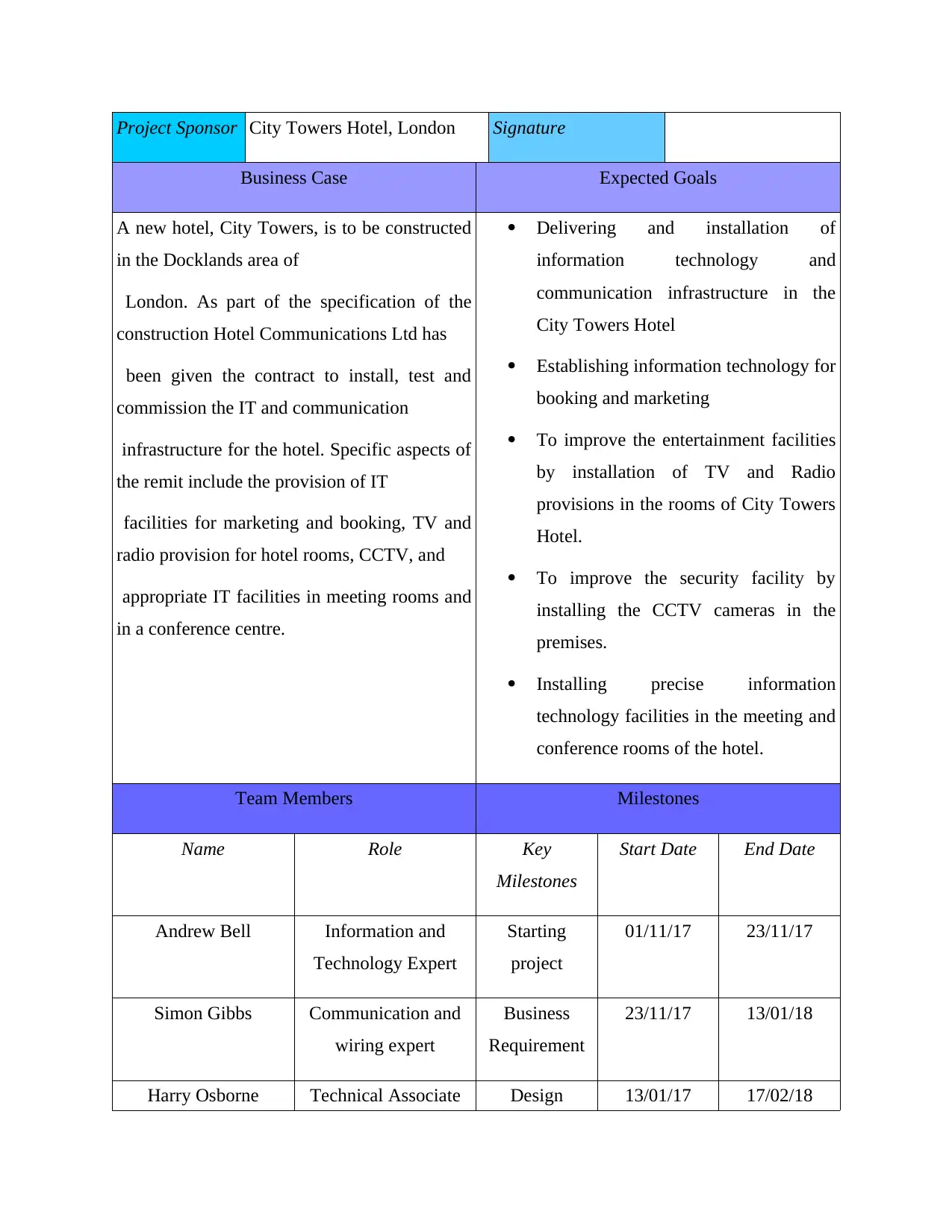
Project Sponsor City Towers Hotel, London Signature
Business Case Expected Goals
A new hotel, City Towers, is to be constructed
in the Docklands area of
London. As part of the specification of the
construction Hotel Communications Ltd has
been given the contract to install, test and
commission the IT and communication
infrastructure for the hotel. Specific aspects of
the remit include the provision of IT
facilities for marketing and booking, TV and
radio provision for hotel rooms, CCTV, and
appropriate IT facilities in meeting rooms and
in a conference centre.
Delivering and installation of
information technology and
communication infrastructure in the
City Towers Hotel
Establishing information technology for
booking and marketing
To improve the entertainment facilities
by installation of TV and Radio
provisions in the rooms of City Towers
Hotel.
To improve the security facility by
installing the CCTV cameras in the
premises.
Installing precise information
technology facilities in the meeting and
conference rooms of the hotel.
Team Members Milestones
Name Role Key
Milestones
Start Date End Date
Andrew Bell Information and
Technology Expert
Starting
project
01/11/17 23/11/17
Simon Gibbs Communication and
wiring expert
Business
Requirement
23/11/17 13/01/18
Harry Osborne Technical Associate Design 13/01/17 17/02/18
Business Case Expected Goals
A new hotel, City Towers, is to be constructed
in the Docklands area of
London. As part of the specification of the
construction Hotel Communications Ltd has
been given the contract to install, test and
commission the IT and communication
infrastructure for the hotel. Specific aspects of
the remit include the provision of IT
facilities for marketing and booking, TV and
radio provision for hotel rooms, CCTV, and
appropriate IT facilities in meeting rooms and
in a conference centre.
Delivering and installation of
information technology and
communication infrastructure in the
City Towers Hotel
Establishing information technology for
booking and marketing
To improve the entertainment facilities
by installation of TV and Radio
provisions in the rooms of City Towers
Hotel.
To improve the security facility by
installing the CCTV cameras in the
premises.
Installing precise information
technology facilities in the meeting and
conference rooms of the hotel.
Team Members Milestones
Name Role Key
Milestones
Start Date End Date
Andrew Bell Information and
Technology Expert
Starting
project
01/11/17 23/11/17
Simon Gibbs Communication and
wiring expert
Business
Requirement
23/11/17 13/01/18
Harry Osborne Technical Associate Design 13/01/17 17/02/18

Peter Parker Supervisor Development 17/02/17 02/04/18
Kelly Jones Financial Advisor Testing
Deployment
2.3.2 Development stage
Budget analysis of the project
In order to conduct the project effectively, the allocation of budget must be allocated
appropriately and precisely for each and every activities of the project. To make the project
successful, the project manager decide the total budget for the project which is £265000. The
allocation and distribution of budget is described below:
Tasks Budget (£)
Initial planning 12000
Gathering resources and preparing budget 83000
Designing system 76000
Development of System 46000
Testing of System 28000
Closure and Transfer 20000
Total Project Budget 265000
Kelly Jones Financial Advisor Testing
Deployment
2.3.2 Development stage
Budget analysis of the project
In order to conduct the project effectively, the allocation of budget must be allocated
appropriately and precisely for each and every activities of the project. To make the project
successful, the project manager decide the total budget for the project which is £265000. The
allocation and distribution of budget is described below:
Tasks Budget (£)
Initial planning 12000
Gathering resources and preparing budget 83000
Designing system 76000
Development of System 46000
Testing of System 28000
Closure and Transfer 20000
Total Project Budget 265000
⊘ This is a preview!⊘
Do you want full access?
Subscribe today to unlock all pages.

Trusted by 1+ million students worldwide
1 out of 20
Related Documents
Your All-in-One AI-Powered Toolkit for Academic Success.
+13062052269
info@desklib.com
Available 24*7 on WhatsApp / Email
![[object Object]](/_next/static/media/star-bottom.7253800d.svg)
Unlock your academic potential
Copyright © 2020–2025 A2Z Services. All Rights Reserved. Developed and managed by ZUCOL.





